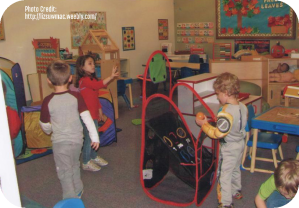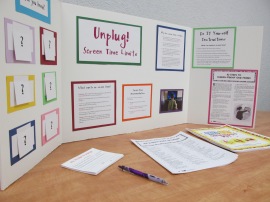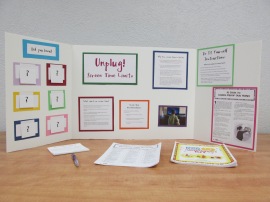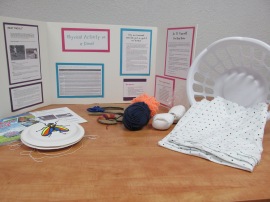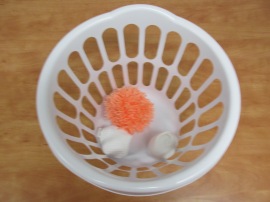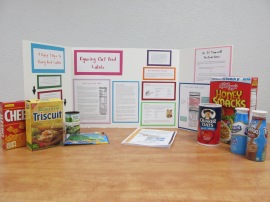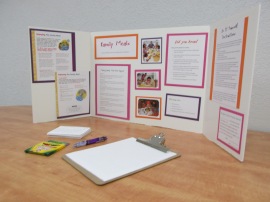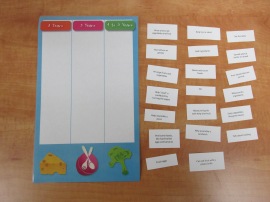Part V of Active Early & Healthy Bites: Home Edition focus on Establishing and Maintaining Healthy Habits for Young Children Across Environments.
Review Part I, Part II, Part III or Part IV

Sue, an early care and education provider in De Pere says, “We are fortunate to have families choose us to help them raise and care for their children, what we teach them now will be with them for the rest of their lives.” So why is early care and education so important to childhood obesity prevention?
- There are over 170,000 slots open to children in Wisconsin’s regulated child care programs. Children who are in care, average of 31+ hours each week. This means that early care and education professionals have a huge influence on a child’s life.
- Families trust early care and education professionals.
- Early care and education professionals understand children and their development! Early care and education professionals are prepared to create healthy environments and help even the youngest child make healthy choices (i.e. knowing a child’s schedule, identifying great opportunities for impromptu and planned lessons).
- Young children look up to early care and education professionals, and thus they are critical role models. An effective early care and education professional takes this to heart and uses their influence to positively impact outcomes for kids.
- Early care and education professional have been successful: View a Success Story Video.

To gain a better understanding of how parents perceive health and physical activity to be incorporated into early care and education settings, KW2 held a number of focus groups in Wisconsin. UW Department of Family Medicine and WI Department of Health Services analyzed the data from the focus groups, finding that:
- Nutrition and physical activity are not necessarily top priorities in choosing child care.
- Parents are somewhat more concerned about nutrition than physical activity in child care.
- Parents are generally not aware of nutrition and physical activity recommendations. They trust child care programs are meeting governmental and professional guidelines.
- Parents do recognize the importance of the relationship between nutrition and physical activity practices at home and in child care.
- Parents want more information and open communication with providers about nutrition and physical activity and less reliance on posted menus and schedules.
From these findings, we think its important for families to have a good understanding of what Wisconsin’s state child licensing rules actually require.
Family Child Care providers who are licensed are required to:
- Plan activities so that each child may use large and small muscles.
- Plan daily activities that are age and developmentally appropriate for each child to include daily indoor and outdoor activities when child is in care for more than 3 hours, except for inclement weather and/or health reasons and that involve both active and quiet play.
- Television, including videotapes and DVDs, may be used only to supplement daily plan for children. No child may be required to watch television.
- For infants and Toddlers, non-mobile awake children shall be placed on their stomach occasionally throughout the day and non-walking children who can creep or crawl shall be given opportunities each day to move freely in a safe, clean, open, warm and uncluttered area.
Licensing group child care group child care programs must:
- Have written program activities which are suitable for the developmental level of each child and each group of children that include large and small muscle development.
- Plan daily activities that are flexible and balanced, including active and quiet activities and indoor and outdoor activities if more than 3 hours a day, unless inclement weather or health reasons.
- Television may only be used to supplement the daily plan for children. No child may be required to watch television.
- For infants and Toddlers, non-mobile awake children shall be placed on their stomach occasionally throughout the day and non-walking children who can creep or crawl shall be given opportunities each day to move freely in a safe, clean, open, warm and uncluttered area.
What’s considered inclement weather?
- Heavy Rain
- Temperatures above 90 degrees Fahrenheit
- Wind chills of 0 degrees Fahrenheit or below for children 2 and older
- Wind chills of 20 degree Fahrenheit or below for children under the age of 2
Other licensing rules related to nutrition and physical activity cover topics like staff development for those who prepare food, outdoor space availability, child guidance practices, available equipment for large muscle development and rest periods.
Licensing rules cover several important facets of nutrition and physical activity, such as ensuring developmentally appropriate practice and defining inclement weather. However, there are also areas of the licensing rules that are vague and could be strengthened, such as including specific amounts of time for opportunities for physical activity or specific nutrition guidelines that go beyond the basic meal pattern. Its important the families know what licensing requires and what their expectations might be beyond licensing rules.

YoungStar is Wisconsin’s Child Care Quality Rating and Improvement System. YoungStar builds upon licensing, with more evidence-based indicators of quality being met with each incremental star level. The four general categories of quality indicators are Provider Training & Education, Learning Environment & Curriculum, Business & Professional Practices, and Health & Wellness.
Two out of the four Health & Wellness points focus on physical activity and nutrition. One point focuses on nutrition and requires programs to follow the guidelines set by the Child and Adult Care Food Program and that programs have policies to address food allergies and special dietary restrictions. One point focuses on physical activity and requires 60 minutes of physical activity each day through active transitions, teacher-led physical activity, outdoor time, tummy time for infants, limited use of restrictive and music and movement.
Making an informed choice about who will care for our children while we are working is one of the most difficult and important decisions a family can make. YoungStar’s five-star quality rating and improvement system supports families in making this decision. The rating scale recognizes practices that early learning settings have in place that are proven to be good for kids. YoungStar gives families a snapshot of a program’s quality to compare with their own views on quality child care. Families can use star ratings and points earned as a tool to engage providers in discussions about their quality improvement efforts and to align what’s most important to their family with the elements a program has to offer.
For more information, view Reading the Stars: Understanding the 5-Star Quality Rating and Improvement System.
Additionally, families can receive referrals to child care programs in their area through their local Child Care Resource & Referral Agency (CCR&Rs). Community-based Child Care Resource & Referral Agencies serve all 72 counties and 11 Tribes. As members of Supporting Families Together Association, they serve the entire state of Wisconsin by:
- Connecting parents with child care services and consumer education to make informed choices when selecting child care.
- Using a strengthening families philosophy to appropriately support families
- Providing guidance to parents on child development, early learning, child abuse and neglect prevention, health and wellness and early care and education and school readiness
Contact your CCR&R Map & Roster today.

When looking for child care or checking in with the program that children are attending, families can ask a variety of questions to start good conversations about nutrition and physical activity needs. Here are just a few examples:
- What is your approach to physical activity and nutrition?
- How do you or your staff integrate physical activity and nutrition education into early learning?
- Do you have a physical activity policy and a nutrition policy? If yes, what do they include?
- How do your lesson plans integrate physical activity and nutrition?
- How does your schedule promote physical activity and nutrition?
- How do you use your behaviors and/or staff behaviors to promote healthy habits?
- How are meals and snacks planned?
- How do you engage and support families in promoting healthy habits early on?

There are many ways in which families can support physical activity and nutrition in early care and education settings. For physical activity and nutrition to be maximized for young children it truly takes a partnership that bridges home and care. Here are just a few ways in which families can support their provider or program:
- Pack warm clothes for outdoor play in the winter. Consider sending extras to make sure kids can go out twice a day and stay warm!
- Make sure solid shoes for active play make it to care every day!
- Think about bringing non-food treats for birthdays and other celebrations!
- Ask what you can do to help make the program more active and encourage healthy eating.
- Volunteer to help start and maintain a garden or organize a walk or ride to care.
- Engage providers and teachers in conversation about gross motor development, physical activity and nutrition.
Resources for Families

While early care and education is a critical setting beyond the home that influence young children’s nutrition and activity habits, we know that its not the only other influential setting. Numerous other environments have an impact, including the business sector, health care settings, faith-based organizations, schools, government and other community-based organizations, like nonprofits. Here are just a few ideas for ways in which communities can get actively involved in supporting the development and maintenance of healthy habits:
- Plant community gardens
- Make joint use agreements (to use playgrounds and space)
- Provide healthy community meals
- Support staff wellness programs
- Support breastfeeding
- Eliminate food deserts
- Organize community physical activities (i.e. runs, bike rides, walks, etc.)
- Create parent advisory committees
- Improve the built environment (bike paths, safe streets, etc.)
- Disseminate accurate and timely information
Remember that many of these strategies can occur across sectors, including churches, mosques, temples, workplaces, businesses, schools, early care and education programs, family resource centers, soup kitchens, homeless shelters, food pantries, service organizations, city government and county government. Here are resources specific to the various sectors:
Early Care and Education
Schools
Faith-Based Communities
Business Sector
City or County Government
Community-Based and Nonprofit Organizations
Health Care Providers

